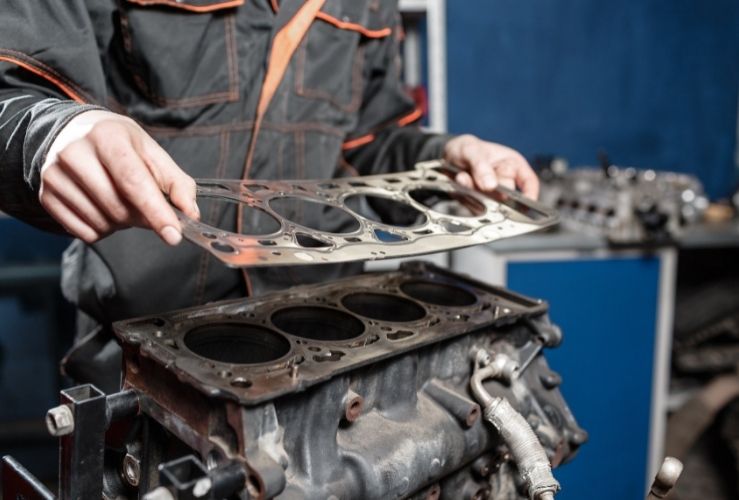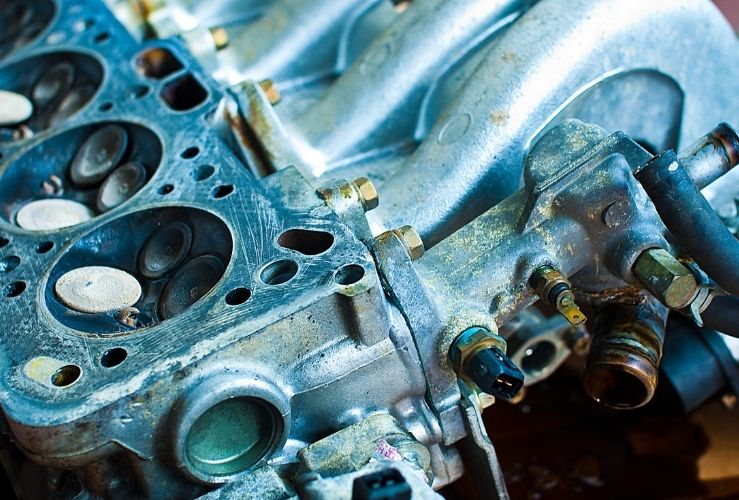How do you diagnose a blown head gasket? Do gasket sealers work? How much for head gasket repairs in the UK?
We answer these questions and more in this head gasket guide...

How to diagnose and fix a blown head gasket
No motorist wants to hear the words “your head gasket has blown" spoken by their mechanic. But is such a fault really so bad?
The head gasket plays a critical role in the combustion process of your vehicle's engine, and if it develops a fault, it could be time consuming and costly to fix.
Here we answer some common questions surrounding faulty head gaskets.
What does a head gasket actually do?
The head gasket is a sheet metal component that sits between the cylinder head at the top of the engine, and the main engine block - where the combustion process takes place.
The head gasket keeps oil, coolant and the combustion process separate. It must deal with extreme pressure from these forces and is the most stressed gasket in the engine.
The head gasket seals the oil pathways between the head cylinder and the engine block; it does the same with coolant, so that both can move around the engine structure as intended.
Critically, the head gasket ensures these two never mix.
What is a head gasket fault?
Many motorists have little idea what a head gasket looks like or exactly where it is positioned. That's not least because it is out of sight, inside the engine.
It is therefore often tricky to diagnose a head gasket fault.
Most 'blown gaskets' or 'perforated gaskets' are caused by overheating.
But this isn't always the case.
Sometimes a fault with the pre-ignition system means fuel combustion timing is out of sync, directing a huge amount of pressure into the cylinder head which can cause perforations later.
Incorrect installation of a head gasket can eventually also cause it to blow.
Head bolts must be tightened just the right amount; not too tight and not too loose. Too tight and the head gasket may be fractured; too loose and a seal may not properly form.

Head gasket symptoms
Head gasket faults usually come with a few clues.
Here are some of the most common symptoms suggesting your head gasket has developed a fault.
White exhaust smoke
White exhaust smoke is almost invariably caused by coolant leaking into your vehicle’s cylinders.
A faulty head gasket may permit coolant into the combustion chamber, which burns off as white smoke. You may still have a head gasket leak even if no white smoke is being emitted.
Note that white exhaust smoke can also result from a crack in the engine block or cylinder head - but it’s often a telltale sign of a head gasket issue.
White-looking oil
If while examining the dipstick or the oil filler cap you see a white liquid, it's possible that coolant has mixed with the oil, giving it a milky shade.
Coolant is usually composed of antifreeze and water. The water component is what causes the frothy or milky appearance of the oil.
However, white-looking oil is not a cast-iron guarantee that you have a head gasket problem. Given the huge expense of repairing a head gasket, it’s important mechanics do not use ‘milky oil’ as the sole evidence of a head gasket fault, although it could be a sign of one.
Power loss
A damaged head gasket could result in decreased combustion engine pressure, resulting in lower engine power.
The head gasket creates a seal between the combustion chamber - containing highly pressurised gases - and the rest of the system.
If the head gasket is damaged or ‘blows’, the seal between the gases and the vehicle’s cooling system and other engine components is gone, permitting the gases to escape.
With less pressurised gas, the reactions inside the engine are less efficient, meaning less power. Damage to engine components will result if the vehicle continues to run.
However, a loss of power should not be taken as evidence of a gasket issue by itself.
But if it occurs alongside other clues such as milky oil and white exhaust smoke, a cracked head gasket could indeed be the culprit.
Water from the exhaust
Water can drip out of your exhaust pipe for a number of reasons - including due to damaged pistons or rings as a result of a blown head gasket.
Water vapour from the exhaust could be a result of coolant entering the cylinder of the head gasket (due to head gasket damage) and burning; any residue may then exit through the exhaust.
Again, taken alone, water dripping from your exhaust is not evidence of a blown gasket.
Water from exhausts can also be caused by condensation in the engine (a more likely cause), or a catalytic converter fault.
Sweet smell from exhaust
A sweet smell from your exhaust may be preferable to petrol, but it suggests a big (and expensive) problem for your gasket.
A leaking or damaged gasket could cause coolant to burn up in the combustion chamber, resulting in the sweet smell of antifreeze. White smoke is likely to accompany this smell.
Engine overheating
It stands to reason that if your coolant is leaking due to a blown gasket, your engine will struggle to stay within its safe temperature range.
Low coolant = high temperatures.
If you see the 'engine overheating' dashboard warning light appear, it could be a head gasket issue.
As with all overheating issues, you should pull over somewhere safe and contact your breakdown recovery provider. Read our article on what to do if your engine overheats.
If you’ve recently had your head gasket replaced and overheating is taking place, it might be because the mechanic forgot to refill the coolant reservoir.
Overheating might also occur due to a fault with another coolant system component, such as the radiator or water pump.
And there is also a chance another part of the engine has been damaged. This could be something as simple as a thermostat, or something more serious, like a crack in the engine block.
Bubbles in coolant reservoir
If combustion gases are getting pushed into the cooling system, bubbles in the coolant may result. These bubbles are often mistaken for boiling coolant.
Special combustion leak test kits are available to verify this issue.
Coolant systems are highly pressurised and can only function properly in a closed system; hoses that move the coolant around the engine, transferring heat away from it.
Note that while bubbles in your coolant could be a sign of a head gasket leak, there are other possible causes such as a faulty coolant cap which is depressurising the system, or air pockets in the radiator.
Coolant levels dropping too quickly
If coolant is leaking from its normal pathways in the engine - e.g. entering the cylinders due to a damaged head gasket - it will exit via the exhaust system and therefore run out sooner than usual.
If your coolant levels are dropping, look out for some of the other signs mentioned in this article, such as milky oil, watery leakage, white exhaust smoke, a bubbling effect in the coolant reservoir, engine power loss, or reduced engine power. And of course, you may see a combination of these symptoms.
However, it may not necessarily mean a head gasket leak - you may simply have a coolant leak elsewhere.
How to look for coolant leaks
Firstly, turn on the ignition and let the engine warm up to operating temperature, so the coolant system is fully pressurised. Then look for coolant leaks.
Check coolant hoses, the water pump, and on the ground below the radiator.
If there are no leaks outside the engine, the leak may well be occurring in the engine block - i.e the head gasket.
How to replace a head gasket
Effectively replacing a head gasket takes a significant amount of mechanical know-how, time, and effort.
You would need to remove the head gasket, clean the surfaces, check the engine components for warping or unevenness, then carefully position the new head gasket and bolt it into place.
Additionally, more modern cars have deep engine placements, which means the exhaust manifold, head, and intake valves may need to be removed in order to access the head gasket.
For the vast majority of car owners, this task is simply too complex, messy, and time consuming.
Head gasket repair cost UK
A head gasket price for repair isn't cheap. It can cost up to £1,000 to fix a head gasket, depending on where you live and the garage you choose. But while costly, it's critical to remedy the situation before much more serious - and more expensive - damage occurs.
If the head gasket does not provide an effective seal, coolant can leak out, potentially warping the cylinder head. Repairing this could cost as much as £900 - or more.
Car value vs head gasket repair costs
If you’re faced with a large repair bill for your blown head gasket, it’s important to consider how much your vehicle is actually worth. If it’s only valued at £2,000, for instance, then paying £1,000 in head gasket repair costs might be unwise.
What about head gasket sealer?
It may be possible to fix any issues by adding head gasket sealer to your engine.
This sealer contains chemicals that plug cracks in the head gasket - which may prevent - or at least delay - a serious fault.
Compared to the head gasket price for a full repair job, it's very affordable - costing up to £40.
You simply add a head gasket sealer to your radiator and it sets about finding cracks and perforations to seal.
It is likely to be more effective if you run your engine for up to 30 minutes and keep your heater and fan switched on.
My head gasket is blown: should I stay off the road?
With a blown head gasket your engine will probably still work - but will be less powerful. This is because the loss of pressure in the combustion chamber translates into much less power.
In addition, if coolant is leaking due to a faulty head gasket, your engine will probably overheat - further damaging your engine.
Furthermore, your engine could be seriously damaged if motor oil has been diluted with coolant, to the degree that it may not be repairable at all.
In short, it is not recommended you drive with a faulty head gasket.
If you think that your vehicle may have suffered from a blown head gasket whilst driving, call your breakdown provider for assistance.
How do I avoid a blown head gasket?
Heat is the prime enemy of the head gasket. To keep it within its safe operational temperature range, ensure coolant is regularly topped up, and that your coolant system is working efficiently.
And as mentioned, installation of head gaskets is also critical. An experienced mechanic will ensure the bolts are in good condition and tightened just the right amount.
If you take the head gasket sealer route, remember it is only a temporary solution. It may be worth getting your local mechanic to add it for you, so it has the best chance of working.
Will a blown head gasket permanently damage my car?
At the first signs of a blown or damaged head gasket, add some sealer to your radiator and take your vehicle to a garage.
Swift action could prevent more serious damage from occurring.
Choosing to drive with a damaged head gasket could result in faulty bearings due to poor lubrication, and overheated parts - both of which could spell the end for your engine, and an eye-watering replacement bill.




